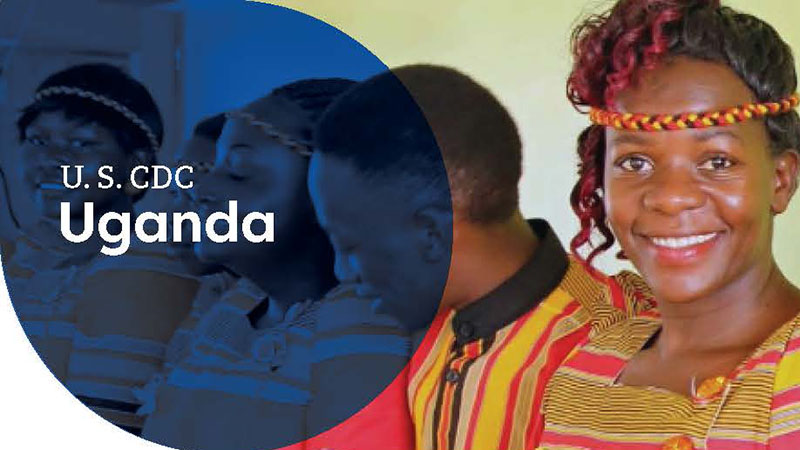At a glance
CDC works with the Ministry of Health (MOH) and other partners to build effective public health collaboration and partnerships, which strengthen the country's core public health capabilities: data and surveillance, laboratory capacity, workforce and institutions, prevention and response, innovation and research, and policy, communications, and diplomacy.

Overview

CDC began working in Uganda in 1991 and established an office in the country in 2000. CDC Uganda works closely with the government and partner organizations to detect, prevent and control infectious disease outbreaks and build and strengthen the country's core public health capabilities. These include data and surveillance, laboratory capacity, workforce and institutions, prevention and response, innovation and research, and policy communications and diplomacy. CDC's work aims to protect the health of our nations and public health around the world.
Global health security
CDC works with the MOH and local partners to support activities across the 11 technical areas outlined in the Global Health Security Agenda (GHSA).
Laboratory systems strengthening
CDC began supporting the MOH in 2003 to build a robust laboratory network with greater diagnostic capacity. This network aims to provide efficient and effective diagnostic and surveillance services for prompt and accurate results. These results help to inform clinical decisions, outbreak response, policies, and programs. Ugandan laboratories experience fewer adverse safety incidents and higher confidence in laboratory services due to increased quality, lower wait times for patients, and enhanced interactions with clinicians.
Key achievements
- CDC supported development of Uganda's first national health laboratory services policy in 2009 and national strategic plans for 2010-2015 and 2016-2022.
- In July 2023, over 40 laboratories in Uganda were internationally accredited, compared to only seven in 2015.
Workforce development
CDC partnered with the MOH and Makerere University School of Public Health to establish a Field Epidemiology Training Program (FETP) in 2015. Participants strengthen their skills in data collection and translation of data into evidence-based action. The program consists of three levels of training: frontline, intermediate, and advanced. Uganda’s FETP-Advanced, also known as the Public Health Fellowship Program, is the only field epidemiology training program in Africa that enrolls post-master’s degree fellows.
Key achievements
As of December 2023, the FETP has graduated 94 fellows from the advanced program and 651 trainees from Intermediate and Frontline FETPs across 118 districts and cities. Building on the success of the FETP, CDC started the Uganda Public Health Fellowship Program-Laboratory Leadership Program (PHFP-LLP) in 2023 —a two-year part-time in-service competency-based training that focuses on laboratory leadership and management skills. In its first year, the LLP supported over 10 outbreak investigations through laboratory coordination and sample management activities in support of holistic epi-surveillance interventions.
FETP fellows have investigated and supported the control of 220 public health emergencies, conducted more than 300 epidemiologic, surveillance and quality improvement projects and published 107 manuscripts in peer-reviewed journals.
Emergency response
Uganda’s Public Health Emergency Operations Center (PHEOC) was established in 2014 with support from CDC. The PHEOC serves as a hub for coordinating preparedness, response, and recovery from public health emergencies. Throughout the COVID-19 pandemic, CDC worked with local partners to prevent the spread of disease across borders and within health facilities, support emergency operations, and promote COVID-19 vaccines, laboratory efforts, disease surveillance, and workforce capacities.
Key achievements
Since 2014, the CDC-supported PHEOC responded to more than 430 events, including outbreaks of mpox, Ebola, Marburg, Rift Valley fever, Crimean Congo hemorrhagic fever, yellow fever, COVID-19, influenza, measles, cholera, typhoid, meningitis, and anthrax.
HIV and TB
As a key implementer of the U.S. President's Emergency Plan for AIDS Relief (PEPFAR), CDC plays an essential role in the fight against HIV and TB. With unmatched scientific and technical knowledge and long-standing relationships with ministries of health, CDC is uniquely positioned to advance HIV, TB, and other global health security activities that keep Americans safe at home and abroad.
Through PEPFAR, CDC provides critical support to Uganda's public health infrastructure, improving the country's ability to prevent, detect, and respond to HIV, TB, and other infectious diseases and minimizing their risk from entering the U.S.
Malaria
CDC has collaborated with Uganda and other partners to support implementation of malaria prevention and control activities. CDC-supported activities have included providing technical input to:
- Provide long-lasting insecticide-treated nets and indoor residual spray (IRS).
- Prevent malaria during pregnancy.
- Strengthen diagnostics and case management.
- Conduct operational research, surveillance, monitoring, and evaluation.
Key achievements
- CDC helped distribute 2.5 million bed nets, 3 million malaria rapid diagnostic tests, and 2 million artemisinin-based combination therapies in 2023.
- In 2023, an indoor residual spray campaign that covered 774,173 structures helped protect 3 million people from malaria.
- Malaria prevalence decreased by 78% and all-cause child mortality decreased by 53% among children under 5 years old.
Immunization
Uganda introduced the hepatitis B birth dose vaccine into its immunization schedule in 2023.
Success story spotlight
Journey of laboratory accreditation
Since 2009, CDC has been collaborating with the MOH to establish a robust laboratory network capable of providing accurate and timely diagnostic results. Through PEPFAR funding, CDC has supported the implementation of the Strengthening Laboratory Management Towards Accreditation (SLMTA) program, resulting in significant improvements in laboratory quality management systems and international accreditation.
The SLMTA program was initially piloted in 19 laboratories, including hospitals and healthcare facilities across Uganda. Witnessing the positive impact on quality results and reduced errors, MOH expanded SLMTA into a national program in 2010. The initiative aimed to enhance laboratory quality management systems at all levels by implementing continuous improvement measures and deploying auditors, assessors, and mentors for HIV-related tests.
As a result of these efforts, at least 150 public laboratories have successfully implemented SLMTA. Of these 71 have achieved international accreditation standards for providing timely, accurate, and reliable test results. These accredited laboratories are strategically located across different geographical areas, including public laboratory hubs that serve as centers of excellence within their catchment areas.
